Topics
Category
Era
Lincoln Mill, Anoka
Minneapolis became known as the "Flour Milling Capital of the World" in 1880, but smaller towns in Minnesota also had successful flour mills. In 1880, two Minneapolis businessmen built the Lincoln Flouring Mill in Anoka, Minnesota. The Lincoln Mill became one the largest country flour mills in the state, surviving until 1939 in spite of catastrophes like the Anoka fire of 1884.
From the 1860s to the 1880s, Anoka and neighboring areas were in search of new industries to replace the dying lumber industry. Many businessmen and speculators moved their investments from sawmills to flour mills. They also used their influence to expand the Soo Line railroad into Minneapolis. Two of Anoka's flour men were William D. Hale and William D. Washburn, brother of General Mills founder and Wisconsin governor Cadwallader Colden (C.C.) Washburn.
In 1880, Hale and William D. Washburn built a large, state-of-the-art mill on the Rum River in Anoka. They called it the Lincoln Flouring Mill, named after Abraham Lincoln because of the Washburn family's political support for him. The Lincoln Mill was not the first mill in Anoka, but it was the largest, with a capacity of 600 to 700 barrels of flour per day. The first flour mill in Anoka was built in 1854 and powered by water. Washburn purchased it several years later, but he built the Lincoln Mill because the first mill could not meet the day's increased demand for flour.
A great fire swept through Anoka in 1884, and the Lincoln Mill was destroyed along with most of the town's industrial area. The fire could have devastated the young town of Anoka, but the people of Anoka pressed on. The mill was rebuilt immediately with an increased capacity of 1,600 barrels of flour per day. It opened in time for the 1885 wheat season. The Washburn Milling Company, which operated the Lincoln Mill, received assistance from Anoka County for the rebuilding. After residents circulated a petition, the Anoka County Board decided to exempt the company from taxation.
In 1889, the Lincoln Mill was sold to an English company with interests in Minnesota flour. The sale was part of a bigger business deal. William D. Washburn and Charles A. Pillsbury merged their companies and created a business syndicate called Pillsbury-Washburn Flour Mills Company. It was owned by the English but managed by Pillsbury and Washburn. In 1910, the company was reorganized and named Pillsbury Flour Mills Company.
During World War I, the Lincoln Mill was used for corn instead of flour. After the war, the mill was reconditioned and used to make Durum wheat products. It was the first mill in the United States to manufacture Durum products, which are used in spaghetti and macaroni, among other things.
Most of Lincoln Mill was torn down in 1933, but the grain elevator and first floor remained. The grain elevator was used until 1939, when the rest of the structure was torn down. In 1950, the riverside tract of land that held the mill was sold to the city of Anoka. As of 2012, Anoka City Hall still stood on the former site of the Lincoln Mill.
Bibliography
Ferrell, Dick. "Milling Around." Twin City Postcard Club 3, no. 2 (February 1979): 4–5.
Goodrich, Albert M. History of Anoka County and the Towns of Champlin and Dayton in Hennepin County, Minnesota. Minneapolis: Hennepin Publishing Company, 1905.
"History of Mill Recalled as Wrecking Continues." Anoka Herald, February 14, 1933.
Kelsey, Kerck. Prairie Lightning: The Rise and Fall of William Drew Washburn. Lakeville, MN: Pogo Press, 2010.
Kuhlman, Charles Byron. "The Mauve Decade of the Flour Trade." The Northwestern Miller 159, no. 4 (July 31, 1929): 403, 431.
Stockhausen, Sharron. Picturing Anoka County: 150 Years of Anoka County History. Virginia Beach, VA: The Donning Company Publishers, 2006.
Ward, Tom, "Anoka County History: No Anoka without the Rum River," ABCNewspapers.com, September 21, 2011.
http://archives.ecmpublishers.info/2011/09/21/anoka-county-history-no-anoka-without-the-rum-river/
Robert M. Frame Minnesota Flour Milling Research Files, [182-]–[198-]
Manuscript Collection, Minnesota Historical Society, St. Paul
Description: Background research files, notes, photocopies, and other material related to Minnesota flour milling, specific flour mills, flour milling technology, and specific individuals connected with the industry. Box 1. Materials on mills in Anoka County, including the Lincoln Mill.
Related Resources
Primary
"The Anoka Mill," The Northwestern Miller 10, no. 6 (August 6, 1880): 81.
Donald N. Gregg Flour Milling Collection, [185-]–[198-]
Manuscript Collection, Minnesota Historical Society, St. Paul
http://www2.mnhs.org/library/findaids/00519.xml
Description: Subject files, including photocopies, photographs, and printed items, related to flour mills and milling in Minnesota and other Midwestern states (c.1850s-1980s). Location 149.I.17.4F. Box 13. Relevant materials filed under "Washburn." Location 149.I.17.9B. Box 19. See materials in the "Lincoln Mill" folders.
"Fire-Swept in a Night." Anoka County Union, August 21, 1884.
"The 'Lincoln Mills' of W.D. Washburn & Co., at Anoka, Minn." American Miller 8, no. 10 (October 1, 1880): 367–368.
Northern States Power Company (Minnesota), 1856–1983
Manuscript Collection, Minnesota Historical Society, St. Paul
http://www2.mnhs.org/library/findaids/00230.xml
Description: Records of certain Minnesota predecessor companies of Northern States Power Company. Location 147.B.14.12F. Box 21. Contains an engineers' pocket memoranda book by T. J. Baker for the Pillsbury Washburn Flour Milling company in Anoka from 1897.
William D. Hale and Family Papers, 1819–1914
Manuscript Collection, Minnesota Historical Society, St. Paul
http://www2.mnhs.org/library/findaids/00871.xml
Description: Correspondence and miscellaneous papers, including correspondence on his milling and lumber interests. Editor's Note: This collection is restricted, and access to it requires the curator's permission, but Charles Byron Kuhlmann's article "The Mauve Decade of the Flour Trade" (see Bibliography) includes an overview and several quotations from these materials about the Lincoln Mill.
I.120
Minnesota Flour Milling [Graphic], c.1900–1982
Sound and Visual Collection, Minnesota Historical Society, St. Paul
Description: Postcards and photoprints with views of flour mills in towns throughout Minnesota.
Secondary
Frame, Robert M. "Mills, Machines, and Millers: Minnesota Sources for Flour-Milling Research." Minnesota History 46, no. 4 (Winter 1978): 152–162.
http://collections.mnhs.org/MNHistoryMagazine/articles/46/v46i04p152-162.pdf
Kuhlmann, Charles B. "The Influence of the Minneapolis Flour Mills Upon the Economic Development of Minnesota and the Northwest." Minnesota History 6, no. 2 (June 1925): 141–154.
http://collections.mnhs.org/MNHistoryMagazine/articles/6/v06i02p141-154.pdf
Powell, William J. Pillsbury's Best: A Company History Since 1869. Minneapolis: The Pillsbury Company, 1985.
Web
The City of Anoka.
http://www.ci.anoka.mn.us/
The Minnesota Alliance for Geographic Education. Northern Suburbs: Railroad Era.
http://lt.umn.edu/mage/go-minnesota/northern-suburbs-railroad-era/
The Mill City Museum.
http://www.millcitymuseum.org/
Related Images
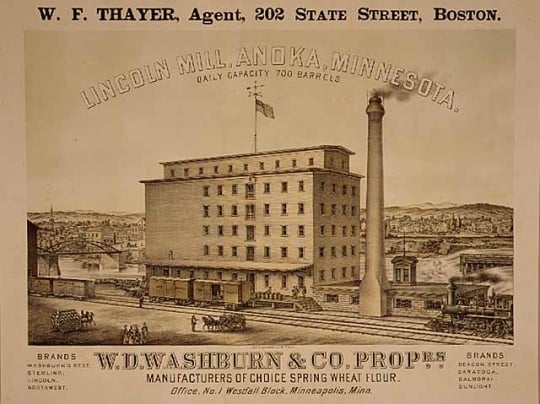
Lincoln Mill, Anoka, Minnesota
Public domain
Holding Location
Articles
More Information

Pillsbury Lincoln Mill after it was destroyed by fire
Public domain
Holding Location
Articles
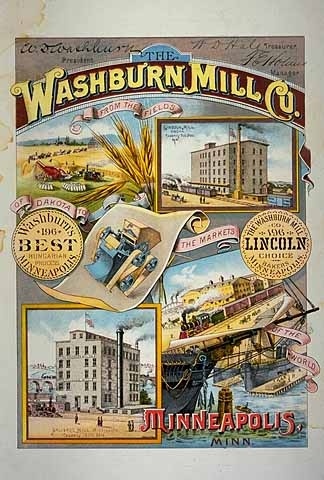
Washburn Mill Company poster
Public domain
Holding Location
Articles
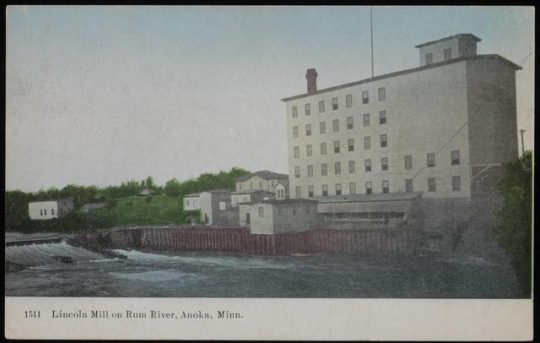
Pillsbury Lincoln Mill on the Rum River in Anoka, Minnesota
Public domain
Holding Location
Articles
More Information
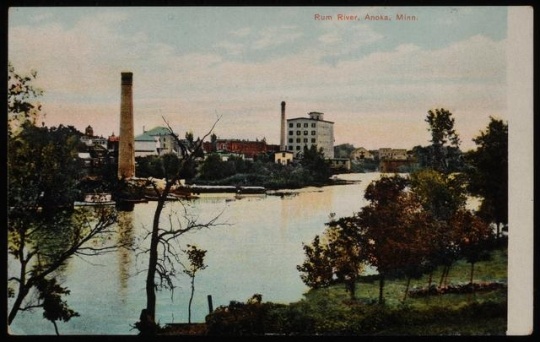
Pillsbury Lincoln Mill and the Rum River, Anoka, Minnesota
Public domain
Holding Location
Articles
More Information

Pillsbury Lincoln Mill and a bird's-eye-view of Anoka, Minnesota
Public domain
Holding Location
Articles
More Information
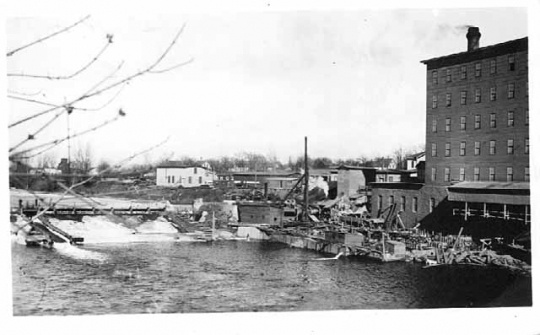
Rebuilding the turbine wheel house on Lincoln Mill
Public domain
Holding Location
Articles
More Information
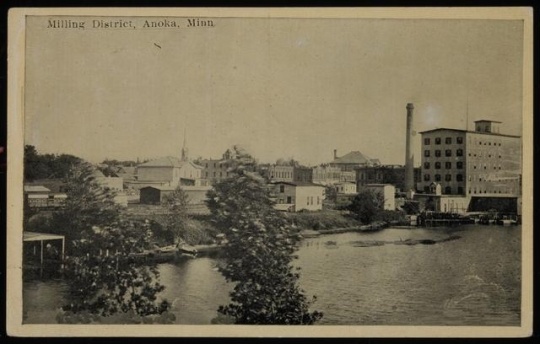
Pillsbury Lincoln Mill and the milling district, Anoka, Minnesota
Public domain
Holding Location
Articles
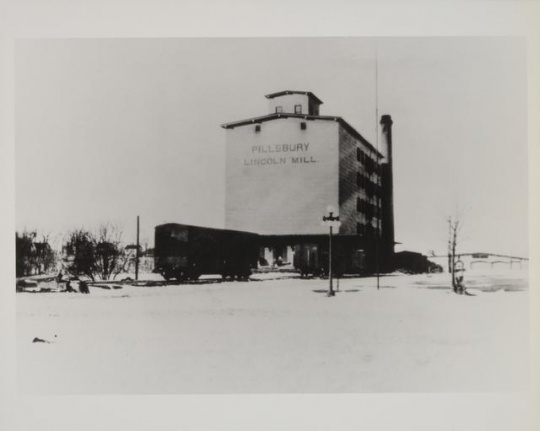
Pillsbury Lincoln Mill, view of the mill, Anoka, Minnesota
Holding Location
Articles
Related Articles
Turning Point
After the Lincoln Flouring Mill is burned down in the Anoka fire of 1884, it is rebuilt immediately with the support of Anoka County.
Chronology
1854
1880
1884
1885
1889
1910
1933
1939
1950
Bibliography
Ferrell, Dick. "Milling Around." Twin City Postcard Club 3, no. 2 (February 1979): 4–5.
Goodrich, Albert M. History of Anoka County and the Towns of Champlin and Dayton in Hennepin County, Minnesota. Minneapolis: Hennepin Publishing Company, 1905.
"History of Mill Recalled as Wrecking Continues." Anoka Herald, February 14, 1933.
Kelsey, Kerck. Prairie Lightning: The Rise and Fall of William Drew Washburn. Lakeville, MN: Pogo Press, 2010.
Kuhlman, Charles Byron. "The Mauve Decade of the Flour Trade." The Northwestern Miller 159, no. 4 (July 31, 1929): 403, 431.
Stockhausen, Sharron. Picturing Anoka County: 150 Years of Anoka County History. Virginia Beach, VA: The Donning Company Publishers, 2006.
Ward, Tom, "Anoka County History: No Anoka without the Rum River," ABCNewspapers.com, September 21, 2011.
http://archives.ecmpublishers.info/2011/09/21/anoka-county-history-no-anoka-without-the-rum-river/
Robert M. Frame Minnesota Flour Milling Research Files, [182-]–[198-]
Manuscript Collection, Minnesota Historical Society, St. Paul
Description: Background research files, notes, photocopies, and other material related to Minnesota flour milling, specific flour mills, flour milling technology, and specific individuals connected with the industry. Box 1. Materials on mills in Anoka County, including the Lincoln Mill.
Related Resources
Primary
"The Anoka Mill," The Northwestern Miller 10, no. 6 (August 6, 1880): 81.
Donald N. Gregg Flour Milling Collection, [185-]–[198-]
Manuscript Collection, Minnesota Historical Society, St. Paul
http://www2.mnhs.org/library/findaids/00519.xml
Description: Subject files, including photocopies, photographs, and printed items, related to flour mills and milling in Minnesota and other Midwestern states (c.1850s-1980s). Location 149.I.17.4F. Box 13. Relevant materials filed under "Washburn." Location 149.I.17.9B. Box 19. See materials in the "Lincoln Mill" folders.
"Fire-Swept in a Night." Anoka County Union, August 21, 1884.
"The 'Lincoln Mills' of W.D. Washburn & Co., at Anoka, Minn." American Miller 8, no. 10 (October 1, 1880): 367–368.
Northern States Power Company (Minnesota), 1856–1983
Manuscript Collection, Minnesota Historical Society, St. Paul
http://www2.mnhs.org/library/findaids/00230.xml
Description: Records of certain Minnesota predecessor companies of Northern States Power Company. Location 147.B.14.12F. Box 21. Contains an engineers' pocket memoranda book by T. J. Baker for the Pillsbury Washburn Flour Milling company in Anoka from 1897.
William D. Hale and Family Papers, 1819–1914
Manuscript Collection, Minnesota Historical Society, St. Paul
http://www2.mnhs.org/library/findaids/00871.xml
Description: Correspondence and miscellaneous papers, including correspondence on his milling and lumber interests. Editor's Note: This collection is restricted, and access to it requires the curator's permission, but Charles Byron Kuhlmann's article "The Mauve Decade of the Flour Trade" (see Bibliography) includes an overview and several quotations from these materials about the Lincoln Mill.
I.120
Minnesota Flour Milling [Graphic], c.1900–1982
Sound and Visual Collection, Minnesota Historical Society, St. Paul
Description: Postcards and photoprints with views of flour mills in towns throughout Minnesota.
Secondary
Frame, Robert M. "Mills, Machines, and Millers: Minnesota Sources for Flour-Milling Research." Minnesota History 46, no. 4 (Winter 1978): 152–162.
http://collections.mnhs.org/MNHistoryMagazine/articles/46/v46i04p152-162.pdf
Kuhlmann, Charles B. "The Influence of the Minneapolis Flour Mills Upon the Economic Development of Minnesota and the Northwest." Minnesota History 6, no. 2 (June 1925): 141–154.
http://collections.mnhs.org/MNHistoryMagazine/articles/6/v06i02p141-154.pdf
Powell, William J. Pillsbury's Best: A Company History Since 1869. Minneapolis: The Pillsbury Company, 1985.
Web
The City of Anoka.
http://www.ci.anoka.mn.us/
The Minnesota Alliance for Geographic Education. Northern Suburbs: Railroad Era.
http://lt.umn.edu/mage/go-minnesota/northern-suburbs-railroad-era/
The Mill City Museum.
http://www.millcitymuseum.org/










